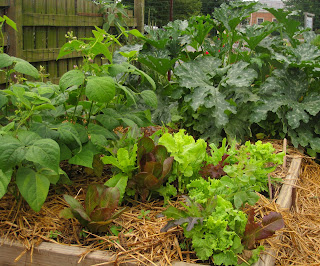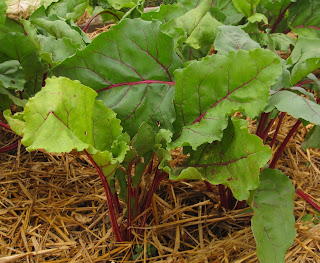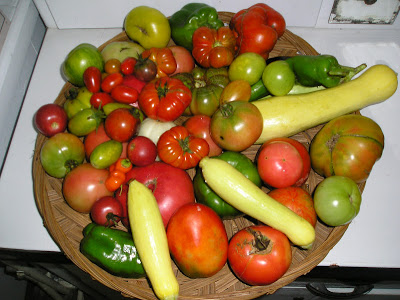 |
Garlic and Multiplier Onions
2012 Seed Bulbs to the Left |
Garlic
I grew two types of garlic this past year: I repeated the
Inchelium Red, a softneck variety, originally purchased from
Territorial Seed Co. and a hardneck variety I call Wilson’s
Fulton Farm garlic, which I think, started out as a variety called
Music, although I’m not sure of that. Maybe Chris Mayer can let us know in the comments section? The seed bulbs were given to me by Bill Dorman last fall, who said he got them from Wilson’s Fulton Farm several years ago. After planting last fall and fertilizing in the spring, the garlic was harvested during the July 4th weekend and has been curing in the barn since. The cool thing about garlic is that after the first year, you don’t need to buy, or acquire any more seed bulbs. Just save your largest bulbs for planting in the fall, for the following year’s harvest.
Hardnecks tend to be stronger in garlic flavor and they have 5-10 uniformly sized cloves around the hard stem, which makes them easier to use. Their storage shelf life after curing is about 5-6 months, which is less than the softnecks. They’re also more cold tolerant and will survive the coldest of winters here in our Zone 6 growing area, and colder zones farther north. And the hardnecks offer a gourmet treat that adds another dimension. They send up a flower stalk called a
scape in late spring. It’s best to cut it off, so the plant gives all of its energy to the bulb, not to flowering and seed. The subsequently cut scapes are a great treat in stir fries and salads. Think of them as sturdier chives, with a garlicky, rather than oniony flavor. Delightful. It’s one of those treats only available to the grower, since they have minimal shelf life, once cut. Add radish seed pods to that category, as well.
Softneck garlic bulbs are what you’re used to buying in the grocery store. They have a longer shelf life, at 9-10 months, sometime up to a year under ideal conditions. I didn’t buy any garlic this past year, using only my home grown ones, although by May or June, the last cloves were starting to sprout and were getting soft. I did have the
dried garlic powder I made last fall to tide me over until harvest time, and the scapes from the hardnecks filled in nicely when I started to run out. The softnecks have large cloves around the outside circling ever smaller ones toward the middle. And of course you can
braid them, since the stems and leaves are flexible. Note: the ones in the grocery store are not recommended for growing here, since in all likelihood, they were grown in a warmer climate, like China or California. Buy your first set from a reputable seed company, save the biggest and best year to year and establish your own strain, tailored to your (very) local growing conditions. Local Farmers Markets are another source of seed garlic that is good to use in your garden.
I will continue to plant both kinds to take advantage of the best characteristics of each.
Multiplier Onions
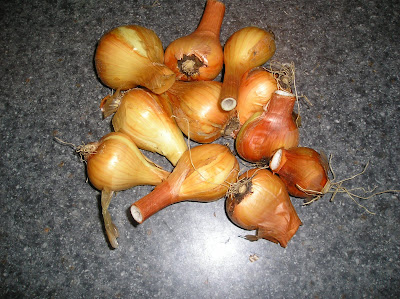 |
| Multiplier Onions for 2012 Crop |
Another gift from Bill Dorman. This is a type of
onion that grows bulblets around the main bulb, sorta like (but not really) the way cloves of garlic cluster. Just like garlic, you save the largest bulbs for replanting, and in this case, harvest the smaller clustering bulbs for storage, fresh eating, and cooking. The bowl in the first picture at the top has the harvested bulbs, and the ones in the middle of the picture show how they grow around the main bulb. Their flavor is somewhat mild, reminiscent of shallots.
Above are the seed ones I’ll be replanting in the fall.
 |
| Bulblets from the Top of Egyptian Walking Onions |
Egyptian Walking Onions
This is another
perennial onion that has the unique characteristic of growing bulblets at the top of the plant. They’re called walking onions, because if you were to leave them on their own, the leaves will bend over and emplant the bulblets in the soil, thus, “walking” across the garden bed, year to year like a slow motion Slinky (Remember those?) This is my third year growing them, again as a gift from Bill Dorman, who got his original supply from
Renfrew’s 4-Square garden when Master Gardeners visited there in the summer of 2007, and Doris Goldman gave out some samples. The small bulblets are quite strong in onion flavor, and, because of their small size, are kind of a pain to peel and use. They make great additions to stocks, however, giving a wonderful onion flavor to the brew, without having to peel them at all. I just add them whole to the simmering stock pot that will later be strained out after extracting their goodness. Another trick is to plant them back in the garden in late August for a fall harvest of scallions, or save them for the spring for the same purpose. In the tender, early sprout stage, their flavor is much milder. Again, as with the garlic and multiplier onions, they are totally year- to-year sustainable, without having to rely on an outside source.
Main Crop Onions
 |
| Freshly Dug Onion Harvest |
I grew three different varieties of main season
onions this year: two storage varieties, and a sweet variety. All were purchased and planted as sets. They were acquired for the
Victory Garden with an oversupply offered to Master Gardeners for our home plots. We sell them for $3.00 a bundle, slightly above cost. And a bundle holds between 60-70 plants. Our supplier is
Dixondale Farms, if you'd like to order directly.
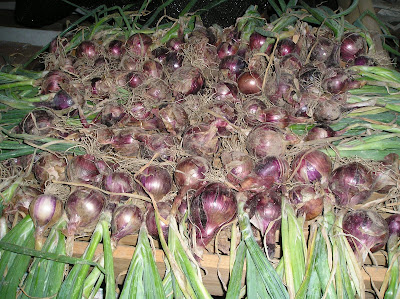 |
| Red Zeppelin |
The first storage variety is called
Red Zeppelin (I love the name), and the other, a yellow one, called
Big Daddy. For storage varieties, a curing period is called for. You harvest from the earth after the leaves have fallen down, but before they yellow. The leaves stay on during the curing process. Placed in a dark, dry place, the drying leaves wick away moisture from the interior of the bulbs.
 |
| Big Daddy |
After about 2-3 weeks of drying, the leaves will have yellowed, and the bulbs are ready for storage. At that point, you cut away the dried leaves, trim the roots, and hang in a mesh basket in your root cellar (dry, cooler temperatures in the 55-65 degree range). A basement, or attached garage suffices. They should keep for 6-8 months.
 |
| Super Star |
The white one is a sweet variety called
Super Star. This is not a good storage variety, so only plant enough to eat before Thanksgiving, since their storage life is limited to 2-3 months. Cut off their leaves upon harvest, since curing is unnecessary for their short shelf life. Refrigeration can extend that life for another month or so. These are sweet enough to rival Vidalias and make great raw additions to burgers and salads throughout the summer and fall.
Onions and Garlic are among the easiest vegetables to grow, requiring little more than planting, a bit of fertilizing (same as is used for your lawn, if you do such things – nitrogen only is needed), and weeding. No staking, no pruning, no spraying, and one of the earlier summer harvests, before your beans and tomatoes. They are virtually pest and disease free.
So, once I add shallots and leeks to my repertoire to go with the above, and the chives that are in my herb garden, plus some of the ornamental ones in the perennial bed, the total conquest and exploitation of the Allium family will be complete.
UPDATE: Well, conquest is farfetched. USDA lists 299 separate species of
Alliums (type 'Allium' in the search box at the link). Maybe it would have been better to say exploitation of
cultivated Alliums.
UPDATE II: Monday 8/1/11 - Chris Mayer informs me by email that after checking with the Farm Manager, the
Fulton Farm Garlic has been grown there for the last 16 years, and the guess is that it was probably Music, given its prominence in Organic Farming circles, but there is no way to tell for sure. Doesn't matter. If you want a source of hardneck garlic, genetically conditioned to our local growing area,
Fulton Farm garlic is a great choice.































